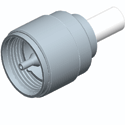 |
  Invented in the 1930's by an Amphenol
engineer named E. Clark Quackenbush, UHF coaxial connectors are
general purpose units developed for use in low frequency systems
from 0.6 - 300 MHz. Invented for use in the radio industry, UHF is
an acronym for Ultra High Frequency because at the time 300 MHz was
considered high frequency. Invented in the 1930's by an Amphenol
engineer named E. Clark Quackenbush, UHF coaxial connectors are
general purpose units developed for use in low frequency systems
from 0.6 - 300 MHz. Invented for use in the radio industry, UHF is
an acronym for Ultra High Frequency because at the time 300 MHz was
considered high frequency.
UHF connectors feature a threaded coupling. Because these
connectors are low-cost, the impedance is variable.
 |
Optional reducing adapters
accommodate a wide range of popular coaxial cables |
 |
 |
Solder termination types require no
special assembly tools |
 |
 |
Crimp termination types provide a
lower cost installation method |
 |
 |
Large-size threaded coupling is
rugged design |
 |
 |
Non-demanding specifications and low
cost |
 |
Antennas |
 |
Cable Assembly |
 |
Low Frequency
Applications |
 |
Public Address Systems |
 |
CB Radios |
|
|
|
| Impedance |
Non-constant |
| Frequency Range |
0 - 300 MHz |
| Voltage Rating |
500 volts peak |
|
| Mating |
5/8-24 threaded coupling |
| Cable Affixment |
Braid solder, set screw, clamp and crimp |
|
| Male Contact |
Brass with silver plating |
| Female Contact |
Beryllium copper with silver plating |
| Bodies |
Brass and die cast zinc |
| Other Metal Parts |
Brass |
| Plating |
Nickel and silver |
| Insulators |
TFE, copolymer of styrene, polystyrene, mica-filled
phenolic and PBT polyester or equivalent |
|
| Temperature Range |
Mica-filled phenolic insulators: -55°C to +149°C Copolymer
of styrene and polystyrene: -55°C to +85°CTFE insulators:
-65°C to +165°C |
| Weatherproof |
Except as noted, all UHF series are
non-weatherproof | Note: These
characteristics are typical but may not apply to all connectors.
 |
 |

